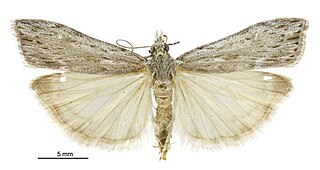
Eugennaea is a genus of moths belonging to the family Tineidae. It was described in 1914 by Edward Meyrick. The genus contains only one species, Eugennaea laquearia, which is endemic to New Zealand. Meyrick described the species from specimens collected by George Vernon Hudson on Nikau stems at Kaeo in January.

Habrophila is a genus of moths belonging to the family Tineidae. This genus was described by Edward Meyrick in 1889. It consists of only one species, Habrophila compseuta, which is endemic to New Zealand.

Tephrosara is a genus of moths belonging to the family Tineidae. It contains only one species, Tephrosara cimmeria, which is endemic to New Zealand.
Petasactis is a genus of moths belonging to the family Tineidae. It contains only one species, Petasactis technica, which is endemic to New Zealand. This species has not been collected since prior to 1888. It is classified as "Data Deficient" by the Department of Conservation.

Pasiphila cotinaea is a species of moth in the family Geometridae. It is endemic to New Zealand. Its larvae feed off Olearia species and the adult moth can be seen on the wing from November to April. This species is regarded as rare.

Scoparia astragalota is a species of moth in the family Crambidae. This species is endemic to New Zealand.

Scoparia harpalea is a moth in the family Crambidae. It is endemic to New Zealand.

Gadira petraula is a species of moth in the family Crambidae. This species is endemic to New Zealand and is only found in mid Canterbury. G. petraula inhabits coastal, montane and low alpine rock sites. The larvae live in rock crevices in a silk shelter from which they emerge to feed. Their host plants are moss or lichens. The adult female is flightless and the male is on the wing in March. This species is classified as "At Risk, Naturally Uncommon" by the Department of Conservation. The 2010 and 2011 Christchurch earthquakes destroyed much of this species preferred habitat. Rock climbers cleaning rocks of the larval host plants are also a threat to the survival of this species.

Eudonia chlamydota is a moth in the family Crambidae. It was named by Edward Meyrick in 1884. It is endemic to New Zealand.

Eudonia periphanes is a moth in the family Crambidae. It was named by Edward Meyrick in 1884. Meyrick gave a detailed description of this species in 1885. It is endemic to New Zealand.

Eudonia cataxesta is a moth in the family Crambidae. It was described by Edward Meyrick in 1884. It is endemic to New Zealand.

Scoparia niphospora is a moth in the family Crambidae. It is endemic to New Zealand.

Crypsitricha roseata is a species of moth in the family Tineidae. It was described by Edward Meyrick in 1913. This species is endemic to New Zealand. The type locality of this species is the suburb of Wadestown, in Wellington.

Monopis ornithias is a species of moth in the family Tineidae. It was described by Edward Meyrick in 1888. This species is endemic to New Zealand.
Monopis typhlopa is a species of moth in the family Tineidae. It was described by Edward Meyrick in 1925. This species is endemic to New Zealand.

Proterodesma byrsopola is a species of moth in the family Tineidae. It was described by Edward Meyrick in 1909. This species is endemic to New Zealand.

Prothinodes grammocosma is a species of moth in the family Tineidae. It was described by Edward Meyrick in 1888. This species is endemic to New Zealand.

Prothinodes lutata is a species of moth in the family Tineidae. It was described by Edward Meyrick in 1914. This species is endemic to New Zealand.

Sagephora steropastis is a species of moth in the family Tineidae. It was described by Edward Meyrick in 1891. This species is endemic to New Zealand.

Tinea accusatrix is a species of moth in the family Tineidae. It was described by Edward Meyrick in 1916. However the placement of this species within the genus Tinea is in doubt. As a result, this species has been referred to as Tinea (s.l.) accusatrix. This species is endemic to New Zealand.


















